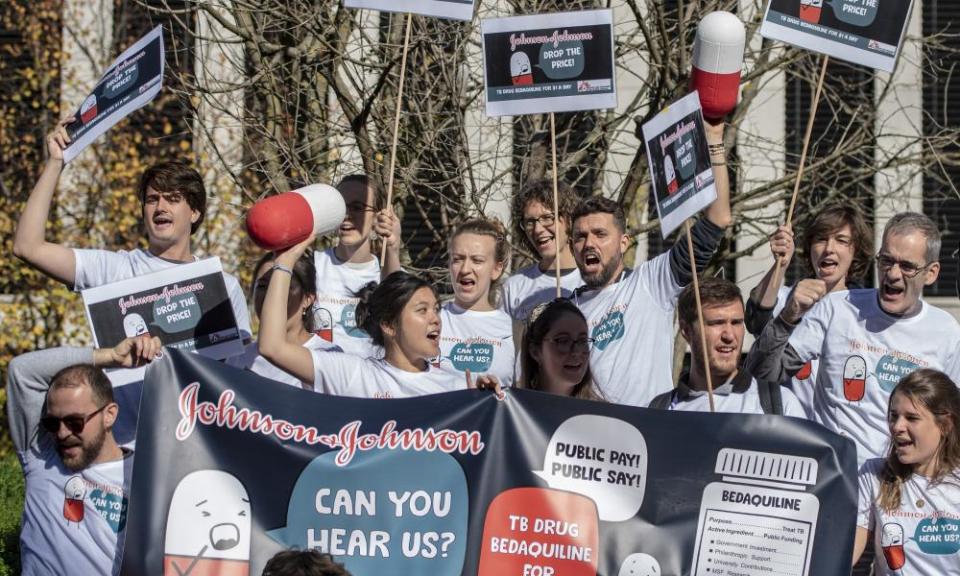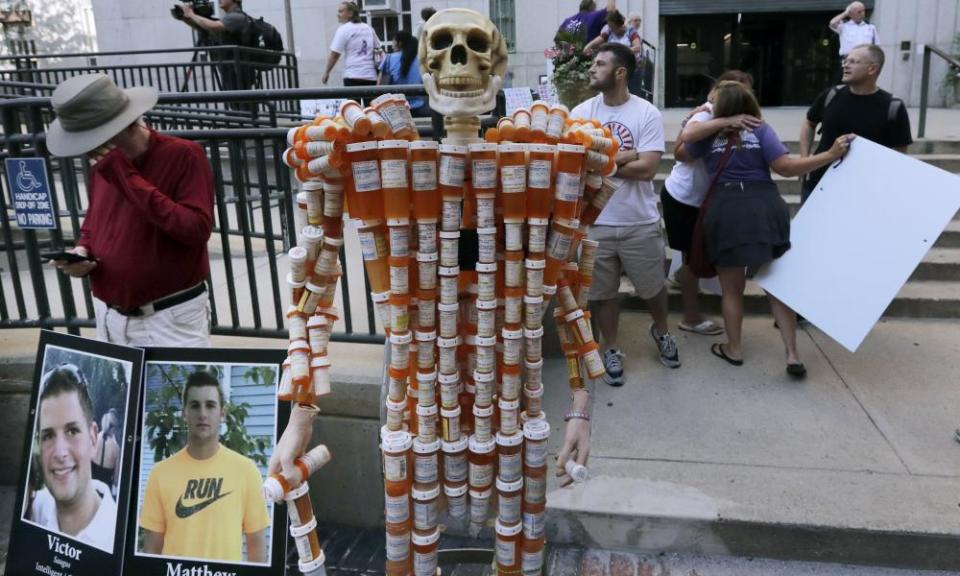Lawsuits, payouts, opioids crisis: what happened to Johnson & Johnson?

For decades, consumers worldwide have named the $347bn pharmaceutical behemoth Johnson & Johnson as one of its most trusted brands. The company returned the favor, instilling its commitment to corporate social responsibility in a 75-year-old “credo” inscribed at company headquarters.
“We believe our first responsibility is to the patients, doctors and nurses, to mothers and fathers and all others who use our products and services. In meeting their needs everything we do must be of high quality.”
Related: Johnson & Johnson opioid ruling explained – the key points
The company has been a household name for more than 100 years with a reassuringly cozy image as the quintessential family brand of baby powder, baby shampoo and the maker of Band-Aids. But it is also the name behind a huge range of drugs and medical devices. And in recent years it has been clobbered by lawsuits and huge payouts involving a dizzying array of products, from an anti-psychotic drug to that famous talcum powder and even a patented opium poppy called Norman.
Now, experts are concerned that one of the world’s most recognizable names and most reliable and valuable companies is caught in no less than an existential crisis, and the public is asking: what happened to Johnson & Johnson?
A series of product misfires and court judgments – with a potential 50,000 more to come and total potential liabilities of $15bn – is challenging both public trust and investor faith.
The pharma giant has seen its reputation drop steadily from ninth place to 57th out of 58 leading pharmaceutical companies since 2014, according to one study by the UK reputation intelligence company Alva.

Last week a jury in Philadelphia awarded $8bn in punitive damages to a man claiming that the company did not warn young men that taking its anti-psychotic drug Risperdal could cause them to grow breasts.
After the judgment, which the company said it plans to appeal, lawyers for the plaintiff said: “Johnson & Johnson is a company which has lost its way” and the jury had chosen to impose punitive damages “on a corporation that valued profits over safety and profits over patients”.
Meanwhile, Johnson & Johnson went through five years of litigation over claims it failed to warn customers that its blood-thinner Xarelto increased the risk of internal bleeding. In March, Johnson & Johnson and co-maker Bayer agreed to pay $775m to settle about 25,000 lawsuits, though neither of the companies admitted liability.
In July, Johnson & Johnson asked a judge in Trenton, New Jersey, to dismiss as many as 14,000 lawsuits alleging its talc-based baby powder causes ovarian cancer. According to the complaints, which have been moving through the legal system since 1999, the company failed to inform the FDA that at least three tests by three different labs from 1972 to 1975 had found asbestos in its talc – in one case at levels reported as “rather high”.
Previous efforts to settle the cases have had mixed results and last year, a Missouri jury ordered Johnson & Johnson to pay $4.69bn to 22 women.
Johnson & Johnson says its baby powder is safe and does not cause cancer.
And on Thursday, the company agreed to a $117m multi-state US settlement over allegations it deceptively marketed its pelvic mesh products, which support women’s prolapsed pelvic organs, but allegedly caused many cases of bleeding, pain and infections.
An investigation concluded that the company violated state consumer protection laws by not fully disclosing the devices’ risks.
But none of those risk as much discomfort as the company’s role in the US opioids crisis, which has claimed 400,000 lives.
Earlier this month, it settled a major lawsuit in a significant climbdown over its prescription painkiller business, just weeks before a multibillion-dollar trial over the public health epidemic.
Johnson & Johnson agreed to pay two Ohio counties a total of $20m to avoid the first in a series of federal trials testing whether opioid painkiller manufacturers, distributors and pharmacy chains are culpable for the worst drug crisis in US history.
Although the settlement was relatively small, it potentially opens the door to payouts totaling billions of dollars to 2,000-plus other counties, municipalities and Native American tribes suing over the damage caused by the crisis.
Dozens of states are also suing.
This all follows a ruling in August when the company lost a civil trial over opioids, where a court in Oklahoma ordered it to pay $572m to the state. The judgment, considered a bellwether, was a defeat for the company on principle but was welcomed by investors who had feared an award as high as $2bn. The company said it would appeal against the ruling.
While Johnson & Johnson’s stock rose 2% after the verdict, the judgment presented a public relations problem for the company.

In addition to selling Duragesic fentanyl patches through a subsidiary, Johnson & Johnson had earned richly as a leading supplier of the opioid in Purdue Pharma’s prescription painkiller OxyContin, developing a special strain of poppy, called Norman, in its opium fields in Australia.
The Johnson family are no longer major stakeholders in the company founded by Robert Wood Johnson in 1886, but the family interest is still valued at $6.3bn, putting them at #46 on Forbes’ richest families list.
Senior patriarch Woody Johnson is the US ambassador to the Court of St James in Britain.
But the family has avoided personal opprobrium, unlike billionaire members of the Sackler family who own Purdue Pharma and have been personally sued and targeted by direct action protests over their philanthropy, led by the American art photographer Nan Goldin.
“My problem with Johnson & Johnson is that they did not give appropriate information with regard to the opioids they were distributing,” says Gail Box, whose son Austin was a University of Oklahoma football star who was prescribed opioid painkillers after back surgery and died of an overdose aged 22.
“Johnson & Johnson were not upfront about the risks,” says Box, whose husband Craig testified at the Oklahoma trial. “They said possibly 1% of people taking opioids would become addicted when they knew the number was far greater.”
The opioids and Risperdal cases have meant a rough 2019 for Johnson & Johnson.
“The company has cultivated this reputation as this family-friendly, public-minded company, but these cases suggest otherwise,” said Carl Tobias, a law professor at the University of Richmond. “So there’s a huge public relations problem … there are 14,000 other cases involved with Risperdal, 15,000 talc cases, 25,000 pelvic mesh cases and possibly thousands of opioid-related lawsuits to follow. They can’t litigate all of them, so are they going to settle?”
Looking back to the 1980s, says crisis management expert Bill Moran, Johnson & Johnson set the standards for corporate responsibility with its swift handling of the crisis when cyanide-laced Tylenol (the company’s branded paracetamol) killed seven in a bottle-tampering spree, quickly withdrawing the product and redesigning the bottle amid a public awareness campaign.
But now, Moran said: “With so many legal judgments against them they’re facing an existential crisis.”
